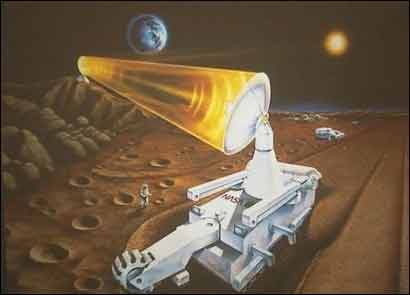How Lunar Soil Could Power the Future

Editor's Note: Each Wednesday LiveScience examines the viability of emerging energy technologies — the power of the future.
The moon is once again a popular destination, as several space-faring nations are talking about setting up bases there. One reason would be to mine fuel for future fusion reactors.
The fuel in this case is helium-3, a lighter isotope of the helium used in balloons. In high energy collisions, helium-3 fuses with other nuclei to release more energy and less waste than the reactions in traditional nuclear reactors.
"If we can show that we can burn helium-3, it is a much cleaner and safer energy source than other nuclear fuels," said Gerald Kulcinski, director of the Fusion Technology Institute at the University of Wisconsin at Madison.
Just 40 tons of this stuff has enough potential energy to meet the total U.S. electricity demand for a year. However, there is almost no helium-3 on Earth. The closest supply is on the moon.
Several space agencies, notably in China, Russia and India, have mentioned helium-3 as a potential payoff for their lunar projects.
"I don't think that the main motivation to go back to the moon is helium-3," Kulcinski said. "But over the long-term, we do face an energy problem."
Sign up for the Live Science daily newsletter now
Get the world’s most fascinating discoveries delivered straight to your inbox.
Fusion solution
All current nuclear power is based on fission, in which a large nucleus (such as uranium) breaks apart into smaller nuclei.
The alternative is fusion, in which two small nuclei come together to form a bigger nucleus and release copious amounts of energy.
A commercial fusion reactor has never been built, but a prototype called the International Thermonuclear Experimental Reactor (ITER) has just begun construction in Cadarache, France. The plan is to generate the needed 100 million degree plasma by the year 2016, but a power plant that can supply electricity might not come online for another 20 years after that.
The reaction that will occur in ITER is the fusing of two hydrogen isotopes: deuterium and tritium. One concern is that tritium is radioactive and a component of nuclear weapons, so care must be taken in dealing with it.
Another problem is the highly energetic neutrons emitted from the deuterium-tritium reaction. These neutrons slam into the reactor walls and cause structural damage. It is expected that the walls in ITER will have to be replaced every one to two years, Kulcinski said.
This is why Kulcinski and others advocate trading the tritium with non-radioactive helium-3.
"The advantage is that it makes very few neutrons," said Rich Nebel of Emc2 Fusion, a company based in Santa Fe, N.M. "This reduces radiation issues and also greatly simplifies the engineering."
Furthermore, the reaction products of helium-3 fusion are charged, so their energy can be directly converted into electricity without having to go through the inefficient step of boiling water to make steam.
Helium sources
Despite its apparent attractiveness, helium-3 is often neglected by fusion researchers. One reason is that the Earth has very little of it. A small portion of helium-3 is collected as an unwanted by-product inside nuclear weapons and sold for about $1,000 per gram, Kulcinski said.
A continuous supply of helium-3 can be found in the solar wind, but our planet's magnetic field deflects these particles away. The same is not true on the moon. The moon has collected 1 million to 5 million tons of helium-3, from the solar wind, over its 4.5 billion year history, Kulcinski said.
Evidence for this was found in the lunar rocks (brought back by the Apollo astronauts and Russian rovers) at a level of 10 to 20 parts per billion.
"Helium-3 is present on the moon, but in very small concentration levels, meaning that many hundreds of millions of tons of soil must be processed to extract a ton of helium-3," said Paul Spudis of the Lunar and Planetary Institute, a NASA-funded research institution.
This extraction requires heating lunar dust particles to around 1,300 degrees Fahrenheit (700 degrees Celsius), Spudis said.
Kulcinski and his colleagues have designed rovers that could move along the surface, scraping up lunar soil and heating it with concentrated sunlight.
Such a mining operation would retrieve 300 times more energy than it uses (including all the energy to fly to the moon and back), Kulcinski estimates. In comparison, mining coal returns 15-20 times the energy put in. His team has estimated that it might cost around $800 million to bring back each ton of lunar helium-3.
This might sound like a lot, but if you could sell the fusion energy at a price comparable to gasoline based on oil at $100 per barrel, the helium-3 would be worth $10 billion per ton.
"Our real challenge is not obtaining the helium-3; it is demonstrating that we can burn it," Kulcinski said.
Tough to burn
Burning helium-3 requires higher initial energy than burning hydrogen isotopes. This is why ITER is not considering helium-3 as a possible fuel at this time.
However, Kulcinski's group works on a different method — called inertial electrostatic confinement (IEC) — for achieving fusion reactions. Instead of using magnetic fields to confine a very hot plasma like ITER plans to do, IEC works by accelerating nuclei towards each other with electric fields.
Kulcinski and his collaborators have managed to sustain nuclear fusion in their small prototype system. The company Emc2 Fusion is also working on a similar design.
However, all of these IEC demonstrations, at least for now, require much more input energy than they can deliver. Most researchers agree that helium-3 is unlikely to be the first fuel used in fusion reactors.
"One should never say never — it may come to pass that helium-3 could become an important source of energy in the coming century," Spudis said. "That time has not come yet. And I suspect that it is still some time off."











